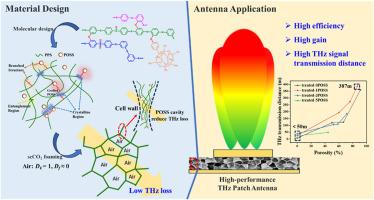Low terahertz transmission loss of polyphenylene sulfide/polyhedral oligomeric silsesquioxane nanocomposite foam for high-performance terahertz antenna
IF 7.7
2区 材料科学
Q1 MATERIALS SCIENCE, COMPOSITES
引用次数: 0
Abstract
The wireless communication industry is advancing toward higher-frequency electromagnetic bands, with the terahertz (THz) band emerging as the target for the next generation of wireless communication. However, the extremely high frequency within the THz band leads to significant signal loss in wireless communication devices (e.g., antennas), necessitating materials with ultralow dielectric properties. To address this challenge, this study developed a novel porous nanocomposite with ultralow dielectric properties by leveraging polyphenylene sulfide (PPS) as the matrix, integrating supercritical CO2 (scCO2) foaming and polyhedral oligomeric silsesquioxane (POSS) for low-dielectric modification, and optimizing PPS's foaming behavior through thermal oxidation treatment. Notably, POSS, as a unique component, introduces a complex coupling effect on the thermal oxidation process of PPS, significantly influencing its foaming behavior. By optimizing this coupling interaction, the obtained porous nanocomposite not only achieves a remarkable reduction in dielectric properties (dielectric constant of 1.2 and dielectric loss of 0.0016 @0.33 THz), but also demonstrates a substantial increase in THz transmittance from 65.9 % to 99.2 % (@0.33 THz). When applied to THz antenna, this porous nanocomposite elevates the THz signal transmission distance from 6.98 m (using pristine PPS substrate) to an unprecedented 387.4 m, showcasing a revolutionary performance breakthrough.

高性能太赫兹天线用聚苯硫醚/多面体低聚硅氧烷纳米复合泡沫材料的低太赫兹传输损耗
无线通信行业正朝着更高频率的电磁频段发展,其中太赫兹(THz)频段成为下一代无线通信的目标。然而,太赫兹频段内的极高频率会导致无线通信设备(例如天线)中的显著信号损失,因此需要具有超低介电性能的材料。为了解决这一挑战,本研究以聚苯硫醚(PPS)为基体,将超临界CO2 (scCO2)发泡和多面体低聚硅氧烷(POSS)进行低介电改性,并通过热氧化处理优化PPS的发泡性能,开发了一种具有超低介电性能的新型多孔纳米复合材料。值得一提的是,POSS作为一种独特的组分,在PPS的热氧化过程中引入了复杂的耦合效应,显著影响了其发泡性能。通过优化这种耦合作用,得到的多孔纳米复合材料不仅介电性能显著降低(介电常数为1.2,介电损耗为0.0016 @0.33 THz),而且太赫兹透射率从65.9%大幅提高到99.2% (@0.33 THz)。当应用于太赫兹天线时,这种多孔纳米复合材料将太赫兹信号传输距离从6.98米(使用原始PPS基板)提高到前所未有的387.4米,展示了革命性的性能突破。
本文章由计算机程序翻译,如有差异,请以英文原文为准。
求助全文
约1分钟内获得全文
求助全文
来源期刊

Composites Communications
Materials Science-Ceramics and Composites
CiteScore
12.10
自引率
10.00%
发文量
340
审稿时长
36 days
期刊介绍:
Composites Communications (Compos. Commun.) is a peer-reviewed journal publishing short communications and letters on the latest advances in composites science and technology. With a rapid review and publication process, its goal is to disseminate new knowledge promptly within the composites community. The journal welcomes manuscripts presenting creative concepts and new findings in design, state-of-the-art approaches in processing, synthesis, characterization, and mechanics modeling. In addition to traditional fiber-/particulate-reinforced engineering composites, it encourages submissions on composites with exceptional physical, mechanical, and fracture properties, as well as those with unique functions and significant application potential. This includes biomimetic and bio-inspired composites for biomedical applications, functional nano-composites for thermal management and energy applications, and composites designed for extreme service environments.
 求助内容:
求助内容: 应助结果提醒方式:
应助结果提醒方式:


